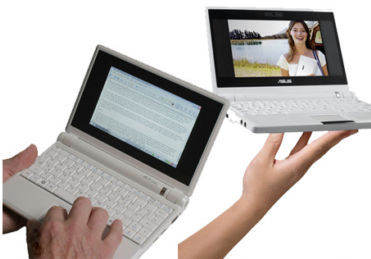A month or so ago I wrote a note about switching to a smaller (even if less powerful) laptop. I now realize that was just one point on a trendline.
Went to the Mason vs. William and Mary basketball game a few weeks ago and while walking around the arena, I bumped into a friend from Mason’s networking staff. He was hunched over, typing away on some sort sort of little black box.
“It’s an EEEPC,” he laughed, “battery weighs more than the computer. Runs Linux.”
Sold me. Added it to my wish list.
Last Thursday I learned that I needed to order a computer for a staff member who’s about to start a text mining project. Aha! Here was an opportunity to save the library some money and continue my pursuit of the small.I gave him the MacBook Pro I’ve used off and on around the office for the past year and ordered myself a replacement device: a 4GB EEEPC. It arrived earlier this week.
This thing really is amazing. Just under two pounds (and under $400) it has roughly the footprint of a DVD case or small paperback. Sure, the little keyboard is cramped and the 7″ screen is pretty small but there’s still a lot here to like:
built-in wireless (802.11 b/g); 4GB SSD drive, SDHC card slot for additional storage; 56K modem; 10/100 Ethernet, 800×600 color video; 3 USB jacks; VGA-out; 2.5-3 hour battery life; 1GB memory and 10-15 second boot times.
The 4GB (on the SSD drive) sounds too small, right? Well, based on a few days use, I’m not so sure it is. As we move closer to pure cloud computing (where your documents and other files live somewhere on the net) four GB is probably sufficient for a second or third computer (particularly when that storage can be augmented with SDHC cards or USB thumbdrives).
Running a derivative of Xandros Linux, it doesn’t take much work to replace the “One Laptop Per Child” sort of simple icon interface that greets you on first bootup with a full-featured KDE desktop. Tweak a couple of system files to resize fonts and add a couple more software repositories and in no time at all you have a very functional (and toteable) travel computer.
I’m finding it very useful for day-to-day sysadmin work. I can quickly monitor one of our headless machines in the server room by jacking an RJ-45 cable into one of the hubs and ssh’ing into the server. It also makes it simple to troubleshoot wireless issues throughout the libraries. Not my sort of thing but it would also be great for notetaking/minutes at meetings (you’d tend to record only the important stuff—gets painful if you have to type too much). I’m doing this post on the EEE and I’m beginning to feel it.
Basic finding: When it weighs less than 2 pounds and boots almost instantly, it’s easy to find reasons to carry this machine around with you.
The EeeUser wiki is a great place for more information (and tweaking guidance).
